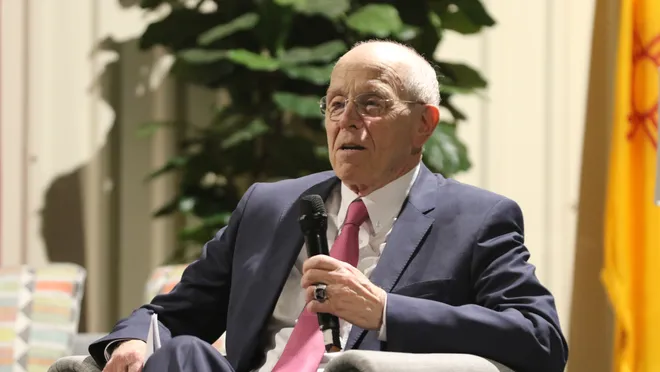 Last week, several Big Oil companies executives met at CERAWeek by IHS Markit energy conference to discuss, among other things, Strategies for the Energy Transition, Climate & ESG. An overriding theme that emerged from the symposium is that Big Oil considers carbon capture technology as being absolutely necessary in our fight against climate change. Exxon Mobil (NYSE:XOM) and Occidental Petroleum (NYSE:OXY) chiefs have said that the world still needs oil and gas, and governments need to focus on mitigating global warming using technologies such as carbon capture and storage (CCS) instead of attacking fossil fuels. And now another Wall Street analyst has thrown its weight behind Big Oil and its love for CCS.
Last week, several Big Oil companies executives met at CERAWeek by IHS Markit energy conference to discuss, among other things, Strategies for the Energy Transition, Climate & ESG. An overriding theme that emerged from the symposium is that Big Oil considers carbon capture technology as being absolutely necessary in our fight against climate change. Exxon Mobil (NYSE:XOM) and Occidental Petroleum (NYSE:OXY) chiefs have said that the world still needs oil and gas, and governments need to focus on mitigating global warming using technologies such as carbon capture and storage (CCS) instead of attacking fossil fuels. And now another Wall Street analyst has thrown its weight behind Big Oil and its love for CCS.
According to energy consultant Wood Mackenzie, we must raise carbon prices dramatically to $160 per ton of CO2 by 2030, up from the current global average of $22 if we hope to successfully combat climate change.
WoodMac analyst Tom Heggarty says that higher CO2 prices could encourage companies to lower their carbon footprint through capturing the carbon and recycling it into new products, a potentially “trillion-dollar industry.”
Carbon capture opportunity
Apart from a dying breed of climate deniers who continue believing that global warming is a hoax, the vast majority of Americans agree that the climate emergency is one of the most pressing issues facing the planet today. A 2020 Pew Research study on views on climate change found that nearly two-thirds say protecting the environment and dealing with global climate change should be top priorities for the president and Congress.
Even more revealing: A good 63% of Americans say stricter environmental regulations are worth the cost.
So it’s clear the vast majority of Americans are aware of climate change and support actions to mitigate the phenomenon. What is not clear is the best way to go about achieving our climate goals as outlined in the 2015 Paris Accord.
Technological innovations in sectors such as renewable energy are certainly playing a big role in climate mitigation. But technology itself is not a policy; Subsidies, on the other hand, are a policy. Perhaps governments should subsidize research in climate science and other related technologies. There is also a strong case to be made that policymakers should allow free trade in solar panels, wind turbines, and other renewable energy equipment so as to lower the cost of generating renewable energy for domestic taxpayers.
Related: Oil Flirts With $70 After The OPEC+ Surprise
But many experts are now arguing that the one policy that will move us closest to hitting our climate targets, at a relatively modest economic cost, is to raise the price of emitting CO2 and other greenhouse gases.
The price of carbon can be raised either through a carbon tax or a cap-and-trade, i.e., a system of quantitative emission limits with tradable emission permits.
$4 Trillion Carbon Marketplace
Big Oil and WoodMac are not the only CCS purveyors.
Last year, Wal van Lierop of Chrysalix Venture Capital and an investor in Canada-based carbon capture startup Svante proposed creating policies that will make carbon markets not only feasible but profitable.
But what is the real cost of carbon emissions? It depends on whom you ask.
The Trump administration estimated that a ton of CO2 causes $1 to $7 worth of domestic social damage.
That seems like a very conservative figure considering that Morgan Stanely estimates that climate change has already cost the world more than $650 billion over the past three years, while Moody’s Analytics predicts that 2° C of warming could cost the global economy $69 trillion by 2100.
The true cost of climate change could be closer to at least $50 per ton, while the global social cost is more like $417 per ton.
Lierop argues that carbon pricing, CCSU technology, and policies need to be such that capturing, repurposing or permanently storing carbon dioxide becomes more profitable than emitting it into the atmosphere. If policymakers were to price CO2 at $100 per ton, the 40 GT of CO2 that the world emits annually would represent a $4 trillion opportunity for carbon capture firms. If that figure seems monstrous, consider that it represents just 5% of the global economy and is certainly lower than the nearly $70 trillion in damages that the economy would otherwise suffer in the face of a full-blown climate disaster.
Related: India: OPEC+ Decision Could Derail Oil Demand Recovery
It’s not such a far-fetched idea, either.
Here in the United States, Section 45Q(a)(1) allows a credit of $20 per metric ton of qualified carbon oxide captured by the taxpayer using carbon capture equipment which is originally placed in service at a qualified facility before the date of the enactment of the Bipartisan Budget Act (DOE). It’s essentially a tax code that provides a performance-based tax credit for carbon capture projects that can be claimed when an eligible project has:
– securely stored the captured carbon dioxide (CO2) in geologic formations, such as oil fields and saline formations; or
– beneficially used captured CO2 or its precursor carbon monoxide (CO) as a feedstock to produce fuels, chemicals, and products such as concrete in a way that results in emissions reductions as defined by federal requirements.
Today, 45Q pays $35/ton for using captured CO2 in Enhanced Oil Recovery (EOR) or synthetic fuels and $50/ton for sequestering CO2 in geological storage. A bill under consideration might amend 45Q to pay an even higher credit for direct air capture: $43.75/ton for EOR or fuels and $65.50/ton for geological storage.
Still, that might be too low to encourage carbon capture firms whose breakeven point is higher than $50/ton. Coupling 45Q with a Fee and Dividend system could be a more effective solution. This system is currently under consideration in the U.S. House of Representatives H.R.763. The fees collected under H.R.763 would be distributed as dividends to all U.S. citizens to offset higher gas prices and elevated costs for hydrocarbon-based goods.
Therefore, WoodMac’s estimate of $160 per ton of CO2 by 2030 could be a very fair estimate..
Paying for carbon capture
In case you are wondering whether the idea will have any takers, there is already an encouraging precedent.
Last year, online payment firm Stripe announced that it will pay $1 million every year for companies to take tons of carbon off the atmosphere. Stripe claims that it already fully offsets its greenhouse gas emissions and plans to invest in green projects that reduce emissions elsewhere.
Microsoft Inc. (NASDAQ:MSFT) has also set a goal to become carbon negative by 2030, meaning that it plans to remove more carbon dioxide from the atmosphere than it emits. The company’s ultimate goal is to remove from the environment by 2050 all of the carbon the company has emitted since it was founded in 1975.
Meanwhile, ride-hailing firm Lyft Inc. (NASDAQ:LYFT) has committed to full carbon neutrality by offsetting the carbon impact of every one of its rides. In the 12 months to May 2019, the company bought 2,062,500 metric tons of carbon offsets, a costly investment to underpin its green credentials. Further, the company is purchasing renewable energy for each office space, driver hub, and electric vehicle mile on its platform.
Media giant Sky has been carbon neutral since 2006; multinational conglomerate Siemens has pledged to become carbon neutral by 2030 while furniture maker IKEA has targeted ‘carbon positive’ status by 2030.
Sadly, energy companies–some of the biggest offenders as far as carbon emissions go —are conspicuous by their absence in this list of more than 100 companies that have committed to lowering their carbon footprint using carbon capture and other technologies.
Hopefully, that will begin to change in a hurry after this year’s CERAWeek.
Source: https://oilprice.com/Energy/Energy-General/WoodMacs-Dramatic-Plan-For-A-600-Carbon-Tax.html




0 Comments